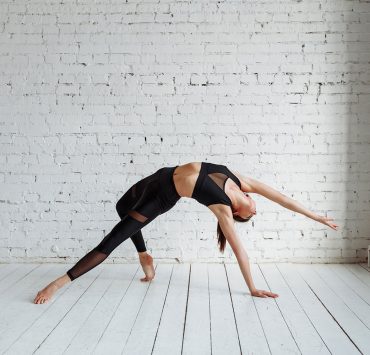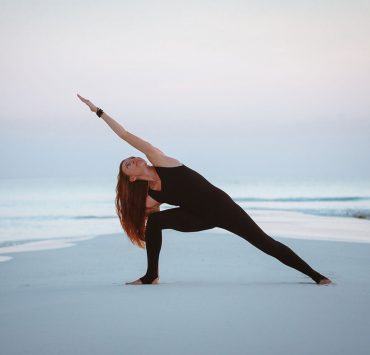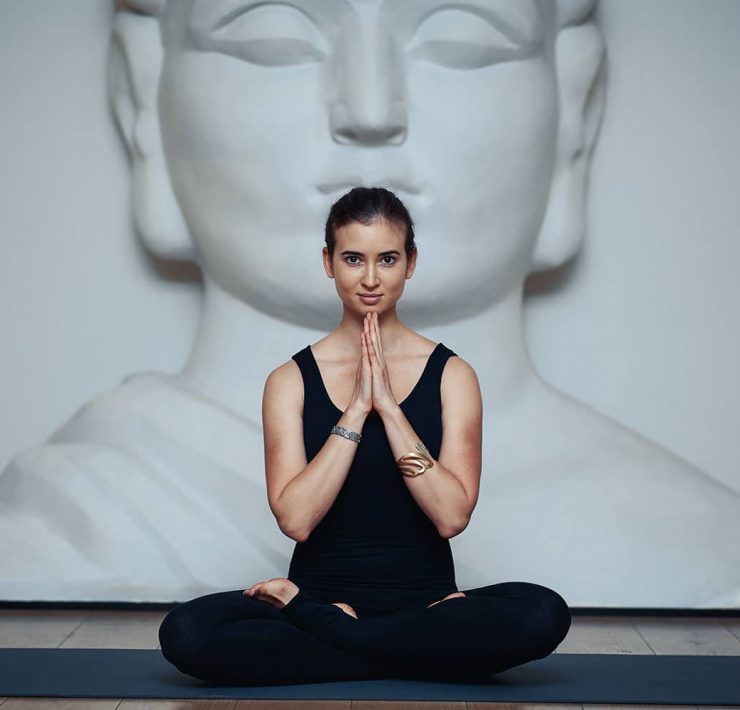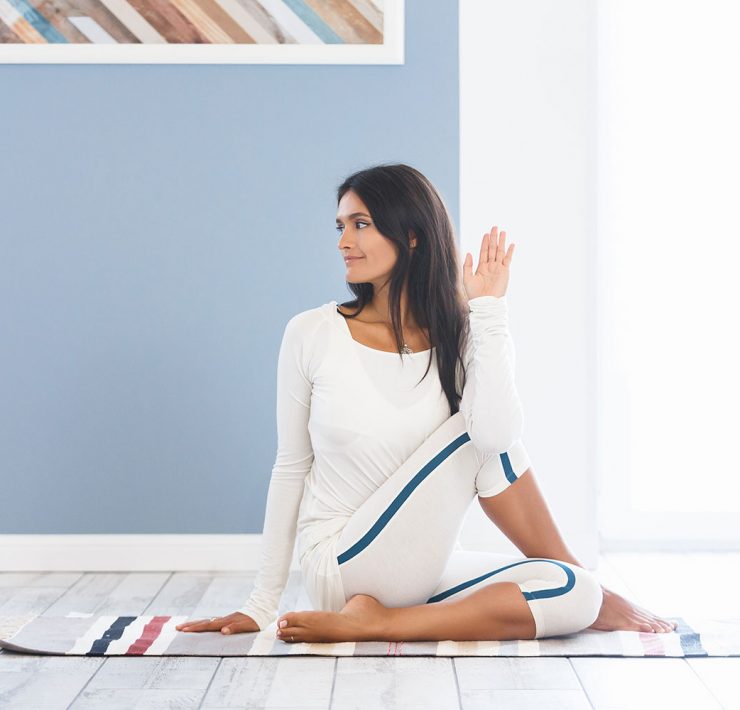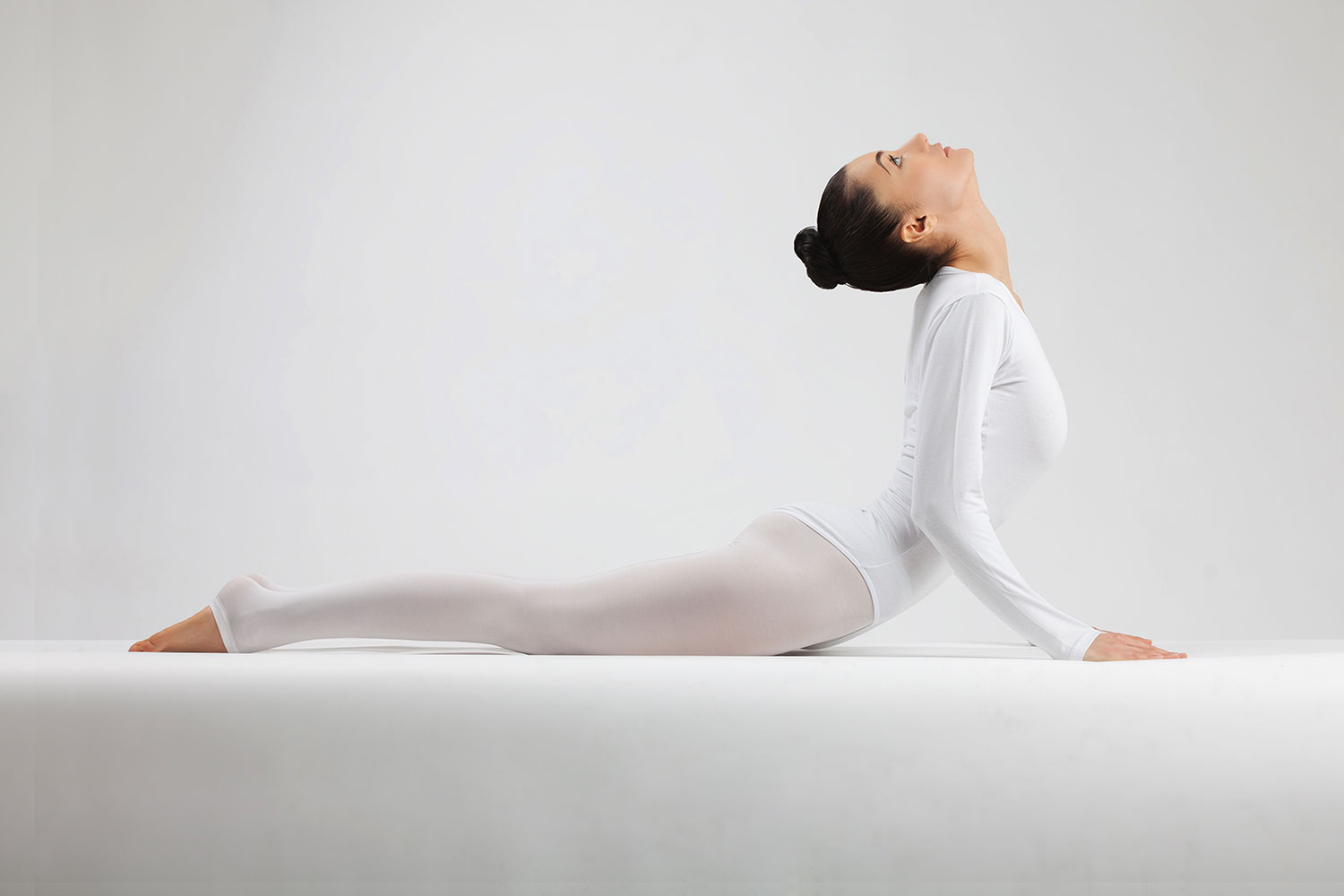
Yoga, meditation, and spirituality are at the top of the…
Back pain is one of the most common ailments of people today. It is a frustrating nuisance that can be limiting on our day-to-day activities. Thankfully, targeted yoga poses can help to relieve tension and strengthen muscles so that we can counteract the pain, while also building a stronger foundation less prone to aches.
Marjaryasana — Cat/Cow Pose

Cat/Cow, or Marjaryasana, is a gentle warm-up pose that is great for relieving back pain. This pose brings movement to the entire spine, while helping to release tension from the neck to the lower back.
Instructions:
Start in a tabletop position, with your hands and knees on the ground. Ensure your palms are stacked directly underneath your shoulders, and your knees underneath your hips.
On an exhale, move into Cat. Round your spine up towards the ceiling while tilting your tailbone down, and tuck your chin down towards your chest. While your head is tilting down, ensure you still leave space between your chin and chest.
On your next inhale, move into Cow. Raise your head and face forward, and tilt your tailbone up, letting your back curve. Ensure you don’t tilt your head back too far or over arch your back, as it can result in more strain.
Continue slowly alternating between Cat and Cow pose a handful of times, breath to movement. Give yourself time to fully feel the stretch as you breathe through the pose.
Adho Mukha Svanasana — Downward Facing Dog Pose

Downward Facing Dog, or Adho Mukha Svanasana, elongates the spine and relaxes the neck. At the same time, it strengthens the back and shoulders, developing a stronger foundation that is less prone to tension.
Instructions:
Start in a tabletop position, with your hands below your shoulders and knees below your hips. On an exhale, engage your core, curl your toes, and lift your knees off the ground, working towards straight legs. Stretch your tailbone back and up towards the ceiling.
Your head should remain active, with your gaze focused in between your legs. Continue to push through your index fingers and thumbs.
In order to get the full body benefits of the pose, bend one knee and then the other to open up your hamstrings. You may also choose to bend both knees at the same time, and then push back through your heels towards straight legs.
Once you feel warmed-up in your legs, settle into stillness. Hold the pose for 30 seconds to a minute, and release back down to your knees.
Urdhvamukha Shvanasana — Upward Facing Dog Pose

Upward Facing Dog, or Urdhva Mukha Svanasana, provides a multitude of benefits for practitioners, including opening the chest and shoulders and stretching out the spine, which all encourage proper posture to alleviate pain.
Instructions:
Lie on your stomach, with the tops of your toes pressed into the floor and your gaze facing down. Place your hands on the side of your body near your waist, with your palms pressing into the floor and elbows pointing up.
On an inhale, press your palms firmly into the ground and begin push your torso slightly forward and then up. Lift your head, torso, hips, and knees, so that your weight is on your hands and the top of your toes.
Be mindful of your shoulders, ensuring they are rolled back and away from your ears. Your gaze should be forward or slightly up, being sure not to force your head back too far.
Breathe through the pose for about 30 seconds. You can release by rolling back down to your stomach, or by pushing back into Downward Facing Dog.
Uttanasana — Forward Fold with Chest Expansion Pose

A Forward Fold, or Uttanasana, uses your own body weight to release tension in the spine and neck. By adding a chest expansion, you are able to get a deeper stretch in the shoulders and upper back.
Instructions:
Start standing with your feet hips-width distance apart, and hinge forward at your hips. Bring your hands to the ground or a block. Since you are focusing on the back and neck, rather than your hamstrings, bend your knees as much as needed.
Release any tension in your neck, allowing your gaze to relax behind you, and stay in this pose for a few breaths.
To move into the chest expansion, remain folded and bring your arms behind your back, with your hands at your lower back. Clasp your hands together, and slowly bring them forward, towards your head. Try to keep your palms together, and don’t force your arms beyond your limits.
Ensure your head remains heavy and relaxed, and that your spine is elongated. Hold the position for about 30 seconds to a minute, and slowly roll up to get out of the pose, releasing your hands at the top.
Ardha Matsyendrasana — Half Lord of the Fishes Pose

Half Lord of the Fishes Pose, or Ardha Matsyendrasana, lengthens, strengthens, and realigns the spine. The twisting element helps to release tension.
Instructions:
Start in a seated position. Bend your right leg and bring your right foot alongside the outside of your left hip, with your leg fully on the floor. Bring your bent left knee over your right, with the sole of your foot fully on the ground by your upper right thigh.
Elongate your spine, and then twist your torso and shoulders over to the left, placing your left hand on the ground behind your glutes. Bring your right arm up, bend at the elbow, and then place it along the outside of your left thigh, with the lower half of your arm extended up. Bring your gaze over your left shoulder.
Stay in this pose for about 30 seconds, and then release and repeat on the opposite side.
Supta Baddha Konasana — Reclining Bound Angle Pose

Reclining Bound Angle Pose, or Supta Baddha Konasana, is a great way to get deep into the hips and relax the low spine.
Instructions:
As you sit on the floor, bend your knees, letting them drop to the side, and bring the soles of your feet together to touch. Carefully roll down to your back, using your hands to guide you. Once laying on the floor, keep your back flat against the mat, and lengthen your tailbone towards your heels. You can rest your hands on your stomach or at your sides.
If you have tighter hips, this pose can be challenging. You may choose to use two blocks underneath your knees to bring them away from the ground, lessening the pressure of the stretch in your hips.
Stay in this pose for 30 seconds or longer, and bring your knees together and into your chest to release from the pose.
Supta Matsyendrasana — Supine Twist Pose

A Supine Twist, or Supta Matsyendrasana, gently stretches your whole back and lengthens your spine, while also giving extra attention to your shoulders and low back.
Instructions:
Begin laying down, with your arms extended horizontally. Bend your knees and place the soles of your feet on the ground, close to your glutes.
Keeping your legs together and bent, swing them to the left side towards the ground, with your right leg on top of the left. Turn your head to the opposite side, letting your gaze fall towards your right hand. After holding for a minute or longer, return your gaze to the center, and repeat on the opposite side.
In this twist, you may feel your opposite shoulder wanting to lift, so be mindful of keeping it grounded and away from your ears.
Viparita Karani — Legs Up The Wall Pose

Legs Up-the-Wall Pose is a relaxing restorative posture that stretches the back of the neck, while also helping to alleviate any back aches.
Instructions:
From a seated position, bring your glutes up toward the wall. Lie onto your back, and swing your legs up against the wall, above your hips. Make any adjustments, such as bringing your hips closer to the wall. You may need to slightly bend your knees to make it more accessible.
Place your arms in a comfortable position, such as out in a “T” shape or stretched above your head. Remain in this restorative pose for about 30 seconds to a minute, with your eyes soft and breaths deep. Slowly and carefully release to one side into fetal pose to get out of the pose.
Halasana — Plow Pose

Plow Pose, or Halasana, is an inversion that stretches the spine and back muscles, helping to release the tension causing you pain.
Instructions:
Begin lying flat on your back. On an inhale, bring your knees into your chest. Engage your core and begin to lift your hips off the ground as you straighten your legs above you. Simultaneously bring your hands alongside your lower back with your elbows on the ground to provide support.
Begin to slowly bring your straight legs behind you, working towards bringing your toes to the ground above your head and aligning your hips over your shoulders.
If you are unable to touch the ground with your toes, continue to support your low back with your hands. If you can touch the ground, extend your arms and clasp your hands together below you, approximately where your glutes were resting when you were lying on your back.
Ensure that you are not allowing tension to build in your neck, and keep lifting up through your tailbone. Hold for 30 seconds, and then release by bringing support back to your lower back, and then slowly rolling back down.
Matsyasana — Supported Fish Pose

Fish Pose, or Matsyasana, counteracts the hunching we find ourselves doing day to day, and can in turn relieve tension in the neck and shoulders. With a supported version, you can still reap the benefits of the pose, while taking on a more restorative position that gently stretches the back.
Instructions:
Find a prop to use, such as a block or rolled up blanket or towel. Lay down on your back, with your prop aligned horizontally across the bottom section of your shoulder blades. This will allow your chest to expand upward in this mild backbend, while your head drapes back. You may also choose to support your head with a block or blanket if you want to lessen the intensity.
Find an arm position that works well for you. You arms can remain at your sides, out to a “T” shape, or stretched out above your head. Once you find stillness, remain in this restorative posture for a minute or longer, allowing yourself to breathe deeply and let go of tension.
Apanasana — Knees to Chest Pose

Knees to Chest Pose, or Apanasana, is a gentle pose that targets your lower back muscles.
Instructions:
Begin by lying on your back, with your feet flat on the floor and knees bent. On an exhale, bring your knees to your chest, placing your hands below your knees. If your flexibility allows for it, you may also wrap your arms around your knees, holding opposite elbows.
Ensure that your back is fully flat on the mat. You may feel an urge to lift your glutes and hips off the mat, so be mindful of lengthening your spine and keeping them grounded. Your shoulders may also want to rise towards your ears, so release tension and focus on keeping them flat to your mat, along with your spine.
If it is comfortable, you may rock side to side or back and forth for a light massage on your spine and low back area. Once still, stay in this pose for 30 seconds or longer, and release back down to lying on your back.
Salabhasana — Locust Pose

Locust Pose, or Salabhasana, is an excellent posture for back tension, as it not only stretches your shoulders and back, but also strengthens those muscles to help prevent pain long term.
Instructions:
Begin by laying on your stomach, with your chin and forehead on the mat. Your arms will be at your sides with your palms facing up. Ensure that your big toes are turning towards each other.
On an exhale, lift your legs, head, upper torso, and arms off the floor. Your weight will be resting on your belly, ribs, and pelvis. In this position, be mindful of keeping your big toes turning towards each other. Continue to elongate through your spine.
It may be tempting to tilt your head backwards. However, in order to prevent injury or strain, keep your gaze a few inches in front of you on the ground to maintain a long neck.
Once you have remained in the pose for about 30 seconds, release back down to the ground.
Urdhva Dhanurasana — Bow Pose

Bow Pose, or Dhanurasana, is an intense backbend that helps to stretch the spine and shoulders, while also strengthening the back muscles.
Instructions:
Start by laying on your stomach. Bend your knees and bring your heels towards your glutes. Reach back for your outer ankles, with your palms facing in. Actively drive your ankles up and towards your head, while simultaneously lifting your head and heart towards the ceiling and back towards your toes.
Hold this pose for 20 to 30 seconds, while focusing on keeping your feet and ankles touching, and shoulders away from you ears. Let go of your ankles and slowly release back down to your stomach.
Paschimottanasana — Seated Forward Fold Pose

Seated Forward Fold, or Paschimottanasana, is a simple posture that provides a deep stretch to your entire back, making it an excellent and accessible pose for anyone with back tension.
Instructions:
Begin seated, with your legs out straight in front of you. Be sure that your spine is elongated and gaze forward. On an inhale, raise your arms above your head. On and exhale, bend at the hips and begin to reach your arms and torso forward.
You can place your hands wherever is accessible. If you are able to reach past your toes with bent elbows, you can place a block at your feet to add length and deepen the stretch.
As you inhale, elongate through your spine, and as you exhale, drive your chest closer to your toes. Stay in this pose for 30 seconds or longer, and bring your torso back up to release.
Salamba Balanasana — Child’s Pose

Child’s Pose, or Balasana, is an excellent restorative pose that helps release tension from your neck while stretching and opening up your back area.
Instructions:
Start on your knees, sitting back onto your heels. Separate your knees from each other so that there is space to fit your torso between your legs, but ensure your big toes remain touching.
On an exhale, bend forward from your hips and bring your torso forward, leading your forehead to the ground. Your torso should rest between your knees.
Extend your arms out in front of you, with your palms resting on the ground and arms remaining active and lifted. Ensure that you are releasing your tailbone towards your heels, and continue to lengthen your spine as you deeply breathe in this position.
Hold the position for a minute or longer, and slowly lead yourself back up to release.
For the best results, regularly practice the poses that best serve you, so that you can find immediate relief while also strengthening your muscles and spine.

What's Your Reaction?
Yoga, meditation, and spirituality are at the top of the list for writer and former nutritionist Amanda Carter. This devoted practitioner enjoys writing about health and wellness just as much as she enjoys living it.






